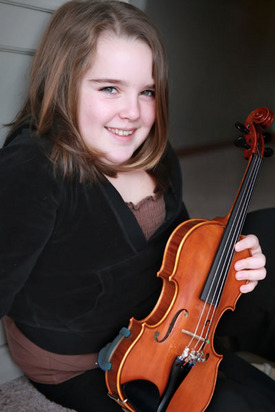« Bringing it home |
Main
| Even more Tetrachords »
 July 31, 2008 | Three-Pronged Education July 31, 2008 | Three-Pronged Education
Ten year-old Coco is blessed with an excellent violin teacher, Nissa de la Torre. Though she's only been taking a year, she's flourished with a well-balanced approach to her instrument, rewarded instantly and developmentally with lifelong musical skills through a three-pronged philosophical approach we adult students could benefit from. Let's look at Nissa's three elements of pedagogy:
Classic/Traditional. The understanding of musical notation is an inarguably important skill. The ability to plow through centuries of literature as well as exchange ideas with other musicians efficiently and effectively has served public and private education since the invention of the printing press. Unfortunately, there are many adult players who skipped this skill in becoming a musician, and while they've been able to get by (some perhaps thrive), there are often times they feel they are missing out on a world of musical opportunity. Best to learn early, but it's never too late to start. Sightreading sessions can be an adventure unto themselves.
Aural/Suzuki. The Suzuki School has decades of success getting students to play well, and listen effectively. Children learn literature and elementary bowing by rote, completely outside of graphical representation. After all, it is about the music not "the notes," and while internalizing music doesn't happen for some as quickly as visually, there is something to be argued about sight being a distraction.
Question: How do you get an electric guitar player to play quietly?
Answer: Put a piece of sheet music in front of him.
Early on, the concept of rich and full tone supersedes reading ability. Posture and physical awareness of the instrument is not impeded by the intense focus of the eye on the printed page. You can go to YouTube and find excellent examples of young artists performing quite successfully.
Folk/Fiddle Tunes. Many of us who tried to leap from the printed pages were verbally abused by our teachers for daring to deviate or reinterpret music in our early education. This is a shame, because so much great folk literature has been handed done solely through oral tradition. A basic tune is introduced and embellished; the performer has a connection with the past and an organic experience reworking it in the present.
Each of these elements are legitimate in themselves, but the best kind of training will enlist all three. One who can read, hear, and be free to embellish will find perpetual enjoyment in life making music.

Posted by Ted at July 31, 2008 1:39 PM

Disclaimer: In the 'Information Age' of the 21st Century,
any fool with a computer, a modem, and an idea can
become a self-professed 'expert." This site does not
come equipped with 'discernment.'
|



